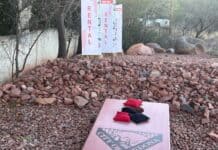Wildfire season is underway in Arizona, and monsoon storms may mean more fires in the upcoming weeks.
As wildfires threaten neighborhoods, residents are advised to understand ‘ready, set and go.’ But what do these terms really mean, and how do they affect residents in areas near wildfires?
And do these terms apply to other emergencies, such as flooding, as well?
Information from the Arizona Emergency Information Network offers help.
Ready, Set, Go is a nationwide program adopted by the 15 Arizona Sheriffs that educates residents about proactive measures to take before an emergency and actions to follow when communities are threatened. The program’s three tenets encourage Arizonans to get READY by preparing now for what threatens their community, be SET by maintaining awareness of significant danger and to GO, evacuate immediately when the danger is current and life-threatening.
The three all-hazard evacuation steps are:
Ready
- Be aware of the hazards that can threaten your community.
- Register with your county/tribal emergency notification system.
- Connect with your Emergency Management/ Sheriff’s Office on social media. Take steps now to prepare for seasonal threats.
- Make a family evacuation and communication plan that includes family phone numbers, out-of-town contacts and family meeting locations.
- Build an emergency go kit with enough food, water and necessary supplies for at least 72 hours. Start with the five P’s; people and pet supplies, prescriptions, papers, personal needs and priceless items. More information is below.
- Check with your neighbors, family, friends and elders to ensure they are READY.
- Keep up to date on local news, weather watches and warnings.
Set
- There is significant danger in your area.
- Residents should consider voluntarily relocating to a shelter or with family/friends outside the affected area.
- Grab your emergency go kit.
- Keep in mind unique needs for your family or special equipment for pets and livestock.
- Stay aware of the latest news and information from public safety officials.
- This might be the only notice you receive. Emergency services cannot guarantee they will be able to notify everyone if conditions rapidly deteriorate. Be SET to GO.
Go
- Danger in your area is imminent and life- threatening.
- Residents should evacuate immediately to a shelter or with family/ friends outside of the affected area.
- If you choose to ignore this advisement, you must understand emergency services may not be able to assist you further.
- Follow instructions from emergency personnel, stay on designated evacuation routes and avoid closed areas.
- The five P’s of Evacuation are as follows:
- People and Pets and other animals/livestock and supplies.
- Prescriptions with dosages , medicines , medical equipment, vision and hearing aids, batteries and power cords.
- Papers including important documents, such as hard copies and/or electronic copies saved on external hard drives or thumb drives, and insurance papers and contacts.
- Personal Needs including clothing, water, baby supplies, food, cash, credit cards, first aid kits, phones and chargers. Items for people with access and/ or functional needs, such as older adults and children.
- Priceless items including photos, irreplaceable mementos and other valuables.
- Many Arizona counties and tribes have a system in place designed to quickly notify an affected area of an emergency by sending a voice or text message to you. Yavapai County residents can sign up for emergency alerts in their area at ycsoaz.gov/community.
Remember that wildfires are never out of season. Create a defensible space to improve a home’s chance of surviving a wildfire and to help protect the firefighters defending the home. The following guidelines are offered by
- Zone 1: Up to 30 feet from buildings: Trim or prune shrubs/vegetation to a height of two feet and provide clear space around each plant of at least four feet.
Remove all flammable material from the ground, under decks and around propane tanks. Keep roofs and gutters clear of debris.
- Zone 2: 30 to 100 feet from buildings. Remove all vegetation that would allow flames to climb up vegetation or buildings.
Trim limbs a minimum of six feet from ground.
Create islands of shrubs, thinning them enough to walk between them. On slopes greater than 20% gradient, treatment should be extended an additional 100 feet from structures. Stack wood piles at least 30 feet from structures. Never prune near power lines, call your local utility company first.
To be prepared for flooding, the important issue is to know your risk.
While some floods develop over time, flash floods can occur within minutes after the onset of a rainstorm. Even areas that are not traditionally flood-prone are at risk after a wildfire, due to changes to the landscape caused by fire. Know the flood risk potential for your home by visiting uagis.maps.arcgis. com.
Use your cell phone and NOAA weather radio to receive weather warnings. Ensure you have NOAA weather radio coverage before hiking or swimming in remote locations.
Know the differences between a weather watch and a weather warning.
A flash flood watch means be prepared to move to higher ground.
A flash flood warning means to immediately move to higher ground if near waterways.
Steep terrain and mountainous areas are especially prone to rapid runoff during monsoon storms and may result in flash flooding miles downstream from where rain is falling.
Avoid streams and slot canyons during and after storms.
More information about preparedness for disasters and other information is available at ein.az.gov/hazards.
